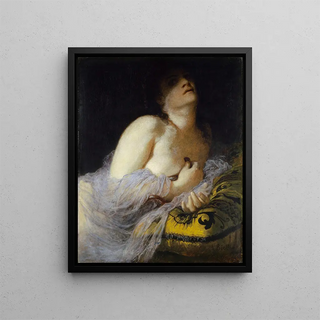Art print | The Death of Cleopatra - Arnold Böcklin


View from behind

Frame (optional)
Art print Cleopatra's Death - Arnold Böcklin – Engaging Introduction
In the vast panorama of art history, certain works stand out for their ability to evoke deep emotions and to capture mythological narratives in an unprecedented way. "Cleopatra's Death" by Arnold Böcklin is a perfect example. This canvas, which depicts the tragic end of the last queen of Egypt, transcends mere historical storytelling to immerse the viewer in a universe where beauty and decadence intertwine. The scene not only portrays Cleopatra's imminent death but also reflects the weight of her legacy and echoes of her power. Through this piece, Böcklin invites the viewer to contemplate not only the personal drama of the sovereign but also the idea of fleeting grandeur.
Style and uniqueness of the work
The uniqueness of "Cleopatra's Death" lies in how Böcklin blends realism with a dreamlike atmosphere. The dark, almost melancholic colors create a heavy ambiance, while the gestures of the characters, filled with palpable emotional intensity, reinforce the tragedy of the scene. The composition is carefully orchestrated, with each element, each character, seeming to play a specific role in the narration. The artist uses light and shadow to emphasize the drama, highlighting Cleopatra's serene face, a striking contrast to the pain of those around her. This stylistic approach, which combines realistic elements and symbolism, is emblematic of Böcklin's art and reflects his desire to transcend simple representation to offer a deeper reflection on the human condition.
The artist and his influence
Arnold Böcklin, Swiss painter of the 19th century, is often associated with the symbolist movement. His artistic vision, which explores themes of death, mythology, and nature, has had a lasting influence on many artists. Böcklin mastered a style that blends romanticism and symbolism, creating works that speak to the collective imagination. "Cleopatra's Death" fits within this lineage, where each brushstroke

Matte finish

View from behind

Frame (optional)
Art print Cleopatra's Death - Arnold Böcklin – Engaging Introduction
In the vast panorama of art history, certain works stand out for their ability to evoke deep emotions and to capture mythological narratives in an unprecedented way. "Cleopatra's Death" by Arnold Böcklin is a perfect example. This canvas, which depicts the tragic end of the last queen of Egypt, transcends mere historical storytelling to immerse the viewer in a universe where beauty and decadence intertwine. The scene not only portrays Cleopatra's imminent death but also reflects the weight of her legacy and echoes of her power. Through this piece, Böcklin invites the viewer to contemplate not only the personal drama of the sovereign but also the idea of fleeting grandeur.
Style and uniqueness of the work
The uniqueness of "Cleopatra's Death" lies in how Böcklin blends realism with a dreamlike atmosphere. The dark, almost melancholic colors create a heavy ambiance, while the gestures of the characters, filled with palpable emotional intensity, reinforce the tragedy of the scene. The composition is carefully orchestrated, with each element, each character, seeming to play a specific role in the narration. The artist uses light and shadow to emphasize the drama, highlighting Cleopatra's serene face, a striking contrast to the pain of those around her. This stylistic approach, which combines realistic elements and symbolism, is emblematic of Böcklin's art and reflects his desire to transcend simple representation to offer a deeper reflection on the human condition.
The artist and his influence
Arnold Böcklin, Swiss painter of the 19th century, is often associated with the symbolist movement. His artistic vision, which explores themes of death, mythology, and nature, has had a lasting influence on many artists. Böcklin mastered a style that blends romanticism and symbolism, creating works that speak to the collective imagination. "Cleopatra's Death" fits within this lineage, where each brushstroke






